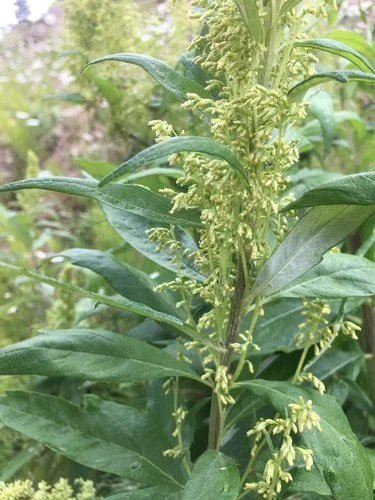Artemisia suksdorfii (Coastal Mugwort)
This native sagebrush is usually seen along the Salish Sea or other coastal areas, and occasionally in fast-draining soils near freshwater. Although herbaceous, it will develop a woody base that will annually produce 1.5-3 ft. tall stems of fragrant, silvery leaves and spike-like flower heads made up of many yellow-green florets, which attract butterflies. Spreading rhizomatously to form thick stands, this drought-tolerant plant prefers full sun and well-drained soil.
Its strong herbal fragrance makes it naturally more deer and bunny resistant. As a tall and shrubby perennial, it’s best placed in the more naturalistic sections of your landscape where you can enjoy its sage-y scent and the wildlife it will attract. Mix it with tall aster-family plants, like our two native Symphyotrichum species.
For a more stylized look, plant it next to the very hardy Rosemary ‘Madeline Hill’ selection and Calamintha — they balance each other nicely with complementary and contrasting colors and textures.
This native sagebrush is usually seen along the Salish Sea or other coastal areas, and occasionally in fast-draining soils near freshwater. Although herbaceous, it will develop a woody base that will annually produce 1.5-3 ft. tall stems of fragrant, silvery leaves and spike-like flower heads made up of many yellow-green florets, which attract butterflies. Spreading rhizomatously to form thick stands, this drought-tolerant plant prefers full sun and well-drained soil.
Its strong herbal fragrance makes it naturally more deer and bunny resistant. As a tall and shrubby perennial, it’s best placed in the more naturalistic sections of your landscape where you can enjoy its sage-y scent and the wildlife it will attract. Mix it with tall aster-family plants, like our two native Symphyotrichum species.
For a more stylized look, plant it next to the very hardy Rosemary ‘Madeline Hill’ selection and Calamintha — they balance each other nicely with complementary and contrasting colors and textures.
This native sagebrush is usually seen along the Salish Sea or other coastal areas, and occasionally in fast-draining soils near freshwater. Although herbaceous, it will develop a woody base that will annually produce 1.5-3 ft. tall stems of fragrant, silvery leaves and spike-like flower heads made up of many yellow-green florets, which attract butterflies. Spreading rhizomatously to form thick stands, this drought-tolerant plant prefers full sun and well-drained soil.
Its strong herbal fragrance makes it naturally more deer and bunny resistant. As a tall and shrubby perennial, it’s best placed in the more naturalistic sections of your landscape where you can enjoy its sage-y scent and the wildlife it will attract. Mix it with tall aster-family plants, like our two native Symphyotrichum species.
For a more stylized look, plant it next to the very hardy Rosemary ‘Madeline Hill’ selection and Calamintha — they balance each other nicely with complementary and contrasting colors and textures.



